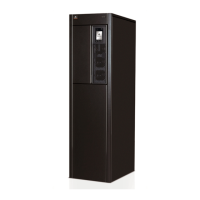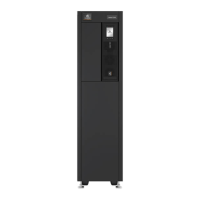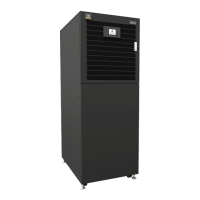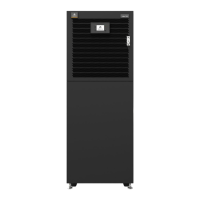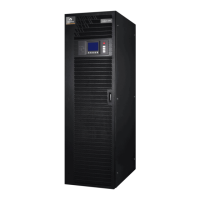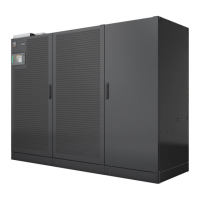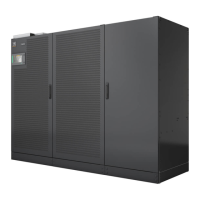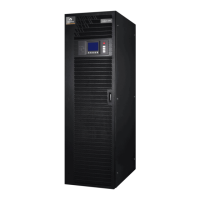Do you have a question about the Vertiv Liebert EXS 15kVA and is the answer not in the manual?
Instructions for safe installation and operation by qualified professionals.
Guidelines for safe storage and operating environment to prevent product damage or malfunction.
Functions for managing battery charging, temperature compensation, and protection settings.
Overview of battery charging methods: constant current, constant voltage, and float charge.
Key battery protection features like low pre-warning and EOD protection against deep discharge.
Environmental and mechanical considerations for planning UPS equipment positioning and cabling.
Guidelines for selecting the UPS location and battery location for optimal performance and safety.
Procedures for connecting power cables, including system configuration and cable sizing.
Requirements for UPS input, bypass, output, and battery cable sizing based on power ratings.
Necessity and guidelines for installing external protective devices like circuit breakers for UPS safety.
Information on connecting signal cables for communication, monitoring, and control functions.
Step-by-step guidance for initial UPS parameter setup, including language, date, and battery settings.
Comprehensive list of UPS alarm messages and their descriptions for troubleshooting.
Important safety warnings and considerations before operating the UPS.
Step-by-step guide for safely starting up the UPS.
Critical checks to perform before initiating the UPS startup sequence.
Detailed steps for starting the UPS in normal mode after installation.
Procedure for starting the UPS directly from battery power without mains input.
Instructions for switching the UPS between different operating modes seamlessly.
How the UPS automatically transfers to battery mode during mains interruptions.
Procedures for transferring the UPS load to the bypass mode for maintenance or overload conditions.
Steps to switch the UPS from bypass mode back to inverter mode.
Procedure to transfer the load to maintenance bypass for internal UPS servicing.
Steps to safely return the load from maintenance bypass to normal inverter operation.
Methods for completely powering down the UPS or shutting it down while maintaining load power.
Detailed steps to safely shut down and disconnect the UPS from all power sources.
Functionality and use of the Emergency Power Off (REPO) port for immediate shutdown.
Critical safety precautions when working with UPS batteries due to high voltage hazards.
Information on valve-regulated batteries, their maintenance, and life expectancy factors.
Requirements for the battery installation environment and guidelines for connecting multiple battery strings.
Protection mechanisms for internal and external batteries, including circuit breaker selection.
Procedures for installing batteries and making proper electrical connections.
Safe procedures for disconnecting and reconnecting internal UPS batteries for maintenance.
Procedures specific to installing parallel UPS systems, including preliminary checks and cabinet setup.
Operating procedures for parallel UPS systems, including startup and maintenance bypass.
Steps for starting up parallel UPS modules in normal operating mode.
Procedures for operating in maintenance bypass mode with parallel UPS systems.
Steps to safely isolate a single UPS module from a parallel system for repair.
Procedures for reintegrating a UPS module back into a parallel system after maintenance.
Steps to completely shut down and disconnect all UPS modules in a parallel system.
Procedures and precautions for maintaining UPS batteries to ensure optimal life and performance.
Instructions for safe installation and operation by qualified professionals.
Guidelines for safe storage and operating environment to prevent product damage or malfunction.
Functions for managing battery charging, temperature compensation, and protection settings.
Overview of battery charging methods: constant current, constant voltage, and float charge.
Key battery protection features like low pre-warning and EOD protection against deep discharge.
Environmental and mechanical considerations for planning UPS equipment positioning and cabling.
Guidelines for selecting the UPS location and battery location for optimal performance and safety.
Procedures for connecting power cables, including system configuration and cable sizing.
Requirements for UPS input, bypass, output, and battery cable sizing based on power ratings.
Necessity and guidelines for installing external protective devices like circuit breakers for UPS safety.
Information on connecting signal cables for communication, monitoring, and control functions.
Step-by-step guidance for initial UPS parameter setup, including language, date, and battery settings.
Comprehensive list of UPS alarm messages and their descriptions for troubleshooting.
Important safety warnings and considerations before operating the UPS.
Step-by-step guide for safely starting up the UPS.
Critical checks to perform before initiating the UPS startup sequence.
Detailed steps for starting the UPS in normal mode after installation.
Procedure for starting the UPS directly from battery power without mains input.
Instructions for switching the UPS between different operating modes seamlessly.
How the UPS automatically transfers to battery mode during mains interruptions.
Procedures for transferring the UPS load to the bypass mode for maintenance or overload conditions.
Steps to switch the UPS from bypass mode back to inverter mode.
Procedure to transfer the load to maintenance bypass for internal UPS servicing.
Steps to safely return the load from maintenance bypass to normal inverter operation.
Methods for completely powering down the UPS or shutting it down while maintaining load power.
Detailed steps to safely shut down and disconnect the UPS from all power sources.
Functionality and use of the Emergency Power Off (REPO) port for immediate shutdown.
Critical safety precautions when working with UPS batteries due to high voltage hazards.
Information on valve-regulated batteries, their maintenance, and life expectancy factors.
Requirements for the battery installation environment and guidelines for connecting multiple battery strings.
Protection mechanisms for internal and external batteries, including circuit breaker selection.
Procedures for installing batteries and making proper electrical connections.
Safe procedures for disconnecting and reconnecting internal UPS batteries for maintenance.
Procedures specific to installing parallel UPS systems, including preliminary checks and cabinet setup.
Operating procedures for parallel UPS systems, including startup and maintenance bypass.
Steps for starting up parallel UPS modules in normal operating mode.
Procedures for operating in maintenance bypass mode with parallel UPS systems.
Steps to safely isolate a single UPS module from a parallel system for repair.
Procedures for reintegrating a UPS module back into a parallel system after maintenance.
Steps to completely shut down and disconnect all UPS modules in a parallel system.
Procedures and precautions for maintaining UPS batteries to ensure optimal life and performance.
| Power Rating | 15 kVA |
|---|---|
| Active Power | 15 kW |
| Topology | Double Conversion Online |
| Operating Temperature | 0°C to 40°C |
| Input Frequency | 50/60 Hz |
| Output Frequency | 50/60 Hz |
| Battery Type | Valve Regulated Lead Acid (VRLA) |
| Battery Runtime | Varies based on load and configuration |
| Relative Humidity | 0% to 95% (non-condensing) |
| Communication Ports | RS232, USB |
